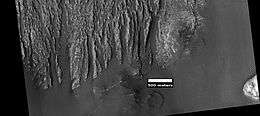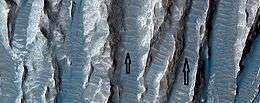Transverse aeolian ridges
Transverse aeolian ridges (TARs) are a type of sand ridge on Mars and are one of the most common landforms on Mars.[1] They are mid-way in height between dunes and ripples; they are not well understood. One possible mechanism for their formation is that larger grains like pebbles are rolled on top of smaller ripples; then, finer dust settles into the cracks, making the TAR larger than typical ripples.[2]
TARs are often seen in low places like valley floors. Currently, they are not moving. TARs are most common near the equator.[3][4]
The term "transverse aeolian ridge", or "TAR" was first used by M. Bourke et al. in 2003.[5]
Gallery
-

Yardangs, as seen by HiRISE under HiWish program. Location is Arsinoes Chaos. The next image shows part of this enlarged so that TAR's can be seen.
-

Close-up of yardangs, as seen by HiRISE under HiWish program. Arrows point to sand ridges that are called "transverse aeolian ridges" (TAR's).
-

Layers in depression in crater, as seen by HiRISE under HiWish program A special type of sand ripple called Transverse aeolian ridges, TAR's are visible and labeled. Location is Hellas Planitia in Noachis quadrangle.
References
- ↑ Berman, Daniel C.; Balme, Matthew R. (2012). "Investigations of transverse aeolian ridges on Mars" (PDF) (conference paper). Lunar and Planetary Science Conference.
- ↑ http://www.uahirise.org/ESP_042625_1655
- ↑ Runyon, Kirby (4 February 2015). "Yardangs in Arsinoes Chaos". HiRISE. The University of Arizona.
- ↑ Berman, Daniel C.; Balme, Matthew R.; Rafkin, Scot C.R.; Zimbelman, James R. "Transverse Aeolian Ridges (TARs) on Mars II: Distributions, orientations and ages". Icarus. 213 (1): 116–130. doi:10.1016/j.icarus.2011.02.014.
- ↑ Bourke, M. C.; Wilson, S. A.; Zimbelman, J. R. (2003). "The variability of transverse aeolian ridges in troughs on Mars" (PDF) (conference paper). Lunar and Planetary Science Conference.